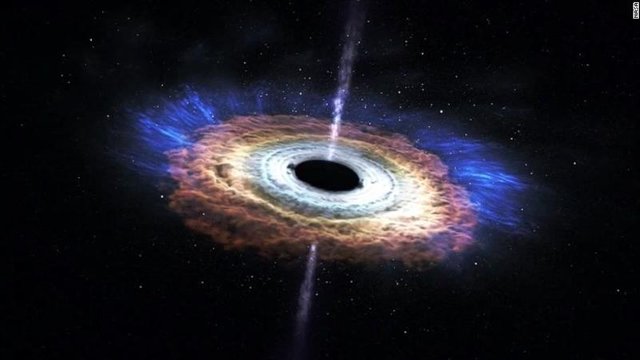What are quasars?
Considered the brightest stars in the universe, quasars are born of the collision of two galaxies. The quasar grows in the center of the new galaxy until it becomes a celestial object so bright that it can be detected at distances greater than 10,000 million light years.

It is believed that its exceptional luminosity is due to the presence of a giant black hole in the heart of the galaxy. The gaseous matter that surrounds it, which rotates very rapidly, reaches high temperatures due to friction and turbulence phenomena. Hence, the radiation so intense that quasars emit.
1963. The discovery of the quasars
In 1963, the Dutch-American astronomer Marteen Schmidt estimated the distance and luminosity of some of these radio sources and concluded that they were galaxies located in the confines of the known Universe. Such galaxies had luminosities far superior to those previously known. Today we know that the objects are called quasars, which obtain their energy from the supermassive black holes located in their central regions. The black hole, surrounded by an accretion disk, is the origin of the bipolar jets of very high speed.
Maarten Schmidt was born in Groningen (The Netherlands) in 1929 and obtained his doctoral thesis at the Leiden Observatory in 1956. Three years later he came to the California Institute of Technology (CalTech) where he began studying the dynamics of galaxies. I frequently use the Hale reflector telescope from Monte Palomar. Schmidt was director of the department of CalTech between 1972 and 1975 and director of the Hale Observatories between 1978 and 1980. In more recent years he devoted himself to the observation of X-ray and gamma sources and their counterparts in the optician.
The host galaxies of the quasars:
The definitive confirmation that quasars are in the centers of distant galaxies came in the last decade of the last century thanks to observations made with the Hubble Space Telescope, the case of quasar 3C 273, the brightest we know (so much that it is possible) see it "with our eyes using a medium-large amateur telescope and a good map of an area of the Virgo
Source
constellation. To enhance the contrast, the light from the object center was masked with a special instrument. A diffuse structure that resembles an elliptical galaxy clearly appears: the galaxy that houses the super-massive black hole that originates the quasar. The host galaxy of 3C 273 has an apparent magnitude of 16 and a size of about 30 seconds of arc in the sky, however it is completely dazzled by the light emitted by the super-massive black hole that inhabits its center. The observations using the Hubble Space Telescope could even reveal details in the thin jet of gas emanating from the poles of the black hole and that it coincides with very high resolution radio observations.
The estimated masses of these astronomical beasts can exceed one billion times the mass of the Sun, although they are usually around the few hundred million solar masses. The mass of the supermassive black hole can be estimated by measuring the "width" of the bright emission lines observed in the spectra of the quasars. As the material is consumed by the black hole in relatively short time, quasars show a brief stage of the evolution of galaxies, this being the reason that we see them only at great distances. It is possible that even our Milky Way passed through an active quasar-like phase a few billion years ago.
http://naukas.com/2013/04/24/el-descubrimiento-de-los-cuasares/
http://www.elmundo.es/elmundo/2009/10/20/ciencia/1256040198.html
https://www.muyinteresante.es/curiosidades/preguntas-respuestas/ique-son-los-cuasares
Partial Source: https://www.taringa.net/posts/ciencia-educacion/17881827/Los-fenomenos-mas-impresionantes-del-universo.html
Posting content that includes copy/pasted text, translations, spun, or re-written articles are not your original work could be seen as plagiarism.
These are some tips on how to share content and add value:
Repeated plagiarized posts are considered spam. Spam is discouraged by the community, and may result in action from the cheetah bot.
If you are actually the original author, please do reply to let us know!
Thank You!
More Info: Abuse Guide - 2017.
Downvoting a post can decrease pending rewards and make it less visible. Common reasons:
Submit
Edit: I removed my vote: the start of this article has been plagiarised from:
https://www.taringa.net/posts/ciencia-educacion/17881827/Los-fenomenos-mas-impresionantes-del-universo.html .
I invite others to do the same.
Downvoting a post can decrease pending rewards and make it less visible. Common reasons:
Submit
Other sources, too for the rest, such as: https://www.muyinteresante.es/curiosidades/preguntas-respuestas/ique-son-los-cuasares
Blacklisted
Downvoting a post can decrease pending rewards and make it less visible. Common reasons:
Submit
Good post. Have an upvote.
I wrote a style guide (link here)for STEM posts that you might find interesting (or not, up to you).
It's good that you source your images otherwise the Steemstem curators might down vote you.
Downvoting a post can decrease pending rewards and make it less visible. Common reasons:
Submit
Hi @procrastilearner check out my edited post above.
Downvoting a post can decrease pending rewards and make it less visible. Common reasons:
Submit
Thx for the heads up.
Downvoting a post can decrease pending rewards and make it less visible. Common reasons:
Submit